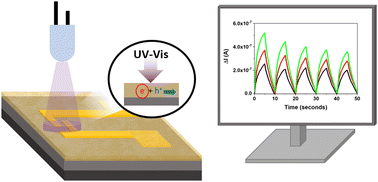Binder polymer influence on the electrical and UV response of organic field-effect transistors†
Abstract
The use of blends of small molecule organic semiconductors (OSCs) with insulating binding polymers has been shown to be a promising route to facilitate the processing of OSCs over large areas using printing techniques. Here we fabricated organic field-effect transistors (OFETs) and phototransistors using the benchmark OSC 7-decyl-2-phenyl[1]benzothieno[3,2-b][1]benzothiophene (Ph-BTBT-10) and blends of this material with polystyrene (PS), poly(pentafluorostyrene) (PFS) and poly(methyl methacrylate) (PMMA). We show that the nature of the binding polymer has a significant impact on the device performance. The OFETs showing the best performance are the ones based on blends of PS since they reveal less interfacial traps, leading to devices with higher mobility, threshold voltage close to zero and high bias stress stability. The lowest OFET performance is found in the devices based on PMMA blends due to the higher density of majority charge carrier (i.e., holes) traps. On the other hand, regarding the response of the devices to UV light, the PFS and pristine films exhibited the highest photoresponse, which was attributed to the higher density of minority charge carrier (i.e., electrons) traps. Therefore, this work demonstrates that the binding polymer is a useful tool to optimise the OFET electrical characteristics as well as its photoresponsivity.

- This article is part of the themed collections: Celebrating ten years of Journal of Materials Chemistry C and Celebrating International Women’s Day: Women in Materials Science


 Please wait while we load your content...
Please wait while we load your content...